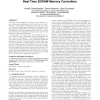Free Online Productivity Tools
i2Speak
i2Symbol
i2OCR
iTex2Img
iWeb2Print
iWeb2Shot
i2Type
iPdf2Split
iPdf2Merge
i2Bopomofo
i2Arabic
i2Style
i2Image
i2PDF
iLatex2Rtf
Sci2ools
DAC
2012
ACM
2012
ACM
Run-time power-down strategies for real-time SDRAM memory controllers
Powering down SDRAMs at run-time reduces memory energy consumption significantly, but often at the cost of performance. If employed speculatively with real-time memory controllers, power-down mechanisms could impact both the guaranteed bandwidth and the memory latency bounds. This calls for power-down strategies that can hide or bound the performance loss, making run-time memory power-down feasible for real-time applications. In this paper, we propose two such strategies that reduce memory energy consumption and yet guarantee realtime memory performance. One provides significant energy savings without impacting the guaranteed bandwidth and latency bounds. The other provides higher energy savings with marginally increased latency bounds, while still preserving the guaranteed bandwidth provided by real-time memory controllers. We also present an algorithm to select the most energy-efficient power-down mode at run-time. We experimentally evaluate the two strategies at run-time by execu...
| Added | 29 Sep 2012 |
| Updated | 29 Sep 2012 |
| Type | Journal |
| Year | 2012 |
| Where | DAC |
| Authors | Karthik Chandrasekar 0001, Benny Akesson, Kees Goossens |
Comments (0)

